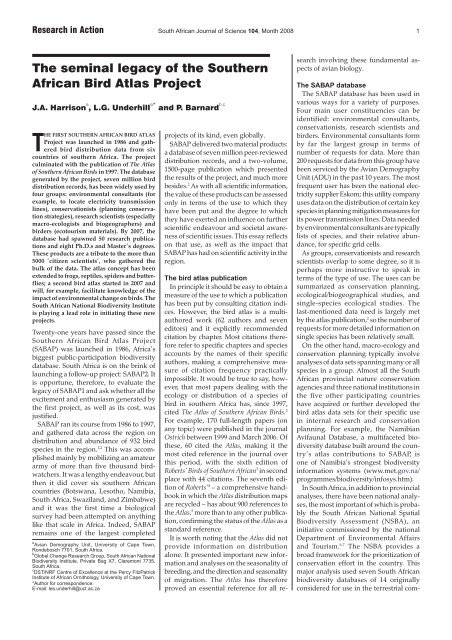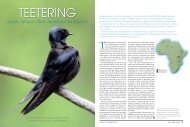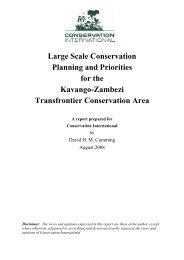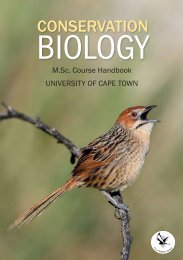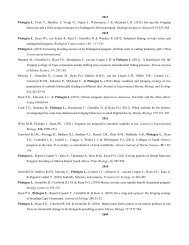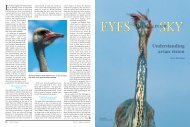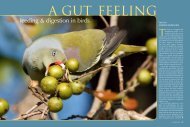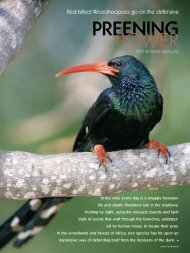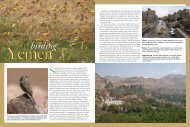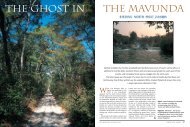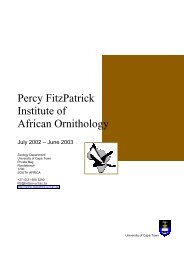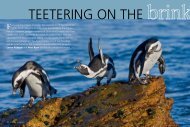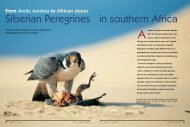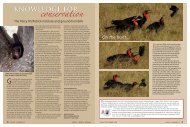the first southern african bird atlas - Percy FitzPatrick Institute of ...
the first southern african bird atlas - Percy FitzPatrick Institute of ...
the first southern african bird atlas - Percy FitzPatrick Institute of ...
- No tags were found...
You also want an ePaper? Increase the reach of your titles
YUMPU automatically turns print PDFs into web optimized ePapers that Google loves.
2 South African Journal <strong>of</strong> Science 104, Month 2008 Research in Actionponent <strong>of</strong> <strong>the</strong> analysis. 7 Of <strong>the</strong> seveneventually chosen, because <strong>the</strong>y weresufficiently comprehensive, one was <strong>the</strong>SABAP database. Ano<strong>the</strong>r was <strong>the</strong> frog<strong>atlas</strong> database, which we discuss below.Two publications <strong>of</strong> direct importanceto <strong>the</strong> national and regional conservation<strong>of</strong> <strong>bird</strong>s are The Important Bird Areas <strong>of</strong>Sou<strong>the</strong>rn Africa 8 and <strong>the</strong> Eskom Red DataBook <strong>of</strong> Birds <strong>of</strong> South Africa, Lesotho andSwaziland. 9 Both <strong>of</strong> <strong>the</strong>se analyses drewheavily on information in <strong>the</strong> SABAPdatabase.Among macro-ecologists, local andinternational interest in <strong>the</strong> SABAP databasehas led to an impressive list <strong>of</strong>publications which acknowledge SABAPas a source <strong>of</strong> essential data. These includepapers on <strong>the</strong> impact <strong>of</strong> specific localenvironmental trends on <strong>bird</strong>s, 10–12 <strong>the</strong>oreticalapproaches to reserve selection, 13–18and analyses <strong>of</strong> macro-ecological andbiogeographical phenomena and concepts.19–29 (For a list, currently <strong>of</strong> 50 publicationsusing <strong>the</strong> SABAP database, see <strong>the</strong>ADU website at www.aviandemographyunit.org.) In particular, <strong>the</strong> use <strong>of</strong> <strong>bird</strong> <strong>atlas</strong>data combined with focused field surveys<strong>of</strong> threatened or endemic species hasallowed <strong>the</strong> estimation <strong>of</strong> populationsizes, streng<strong>the</strong>ning <strong>the</strong> link between<strong>atlas</strong>ing and red-listing processes inbiodiversity conservation. 19By 2006, eight postgraduate studentshad completed <strong>the</strong>ses based on analyses<strong>of</strong> <strong>the</strong> SABAP database. 29–36 These studentswere at five universities (three in SouthAfrica and two in <strong>the</strong> U.K.), and explored<strong>the</strong> database from a variety <strong>of</strong> disciplinesand perspectives, fur<strong>the</strong>r emphasizing itsrichness.Birders and landowners have occasionallyaccessed <strong>bird</strong> <strong>atlas</strong> data to use as aguide to <strong>bird</strong>ing in specific areas, andfor <strong>the</strong> development <strong>of</strong> eco-tourismmaterials. These uses were, however,discouraged to some extent by <strong>the</strong> initialapplication <strong>of</strong> data-extraction fees. Weexpect that <strong>the</strong>se types <strong>of</strong> use will increasenow that <strong>the</strong> <strong>bird</strong> <strong>atlas</strong> data are increasinglyavailable online, free <strong>of</strong> charge atwww.<strong>bird</strong>s.sanbi.org and www.aviandemographyunit.orgPublic awareness and participationThe impact <strong>of</strong> SABAP on public awareness<strong>of</strong> <strong>bird</strong>s and <strong>the</strong>ir attendant conservationissues has not been measuredacross society, nor would it be easy to doso. Never<strong>the</strong>less, <strong>the</strong>re is unanimitywithin <strong>bird</strong>ing, ornithology and conservationcircles that SABAP had an enormousinfluence on <strong>bird</strong>ers and o<strong>the</strong>rs in SouthAfrica and beyond. There were more than5000 direct contributors to SABAP. Inaddition to <strong>the</strong>se, many citizens wereaware <strong>of</strong> <strong>the</strong> project, especially rural landowners,who frequently allowed <strong>atlas</strong>ersto explore <strong>the</strong>ir properties. This awarenesson <strong>the</strong> part <strong>of</strong> landowners aloneprobably had a salutary effect on <strong>the</strong>irsense <strong>of</strong> <strong>the</strong>ir role as stewards <strong>of</strong> <strong>the</strong>region’s biodiversity.Many <strong>bird</strong>ers testify that <strong>atlas</strong>ing became,for <strong>the</strong>m, a more rewarding form <strong>of</strong><strong>the</strong>ir hobby because it had a clear and alarger purpose. Both <strong>the</strong> concept and <strong>the</strong>activities <strong>of</strong> <strong>the</strong> <strong>atlas</strong> helped <strong>the</strong>m to see<strong>bird</strong>s and <strong>the</strong>ir hobby in <strong>the</strong> context <strong>of</strong>broader ecological issues. The need toidentify species positively so that onecould record as many as possible in gridcells – <strong>the</strong> sampling units <strong>of</strong> <strong>the</strong> <strong>atlas</strong> – becamea strong incentive to hone identificationskills. The imperative to recordcomprehensive lists <strong>of</strong> species encourageda greater awareness <strong>of</strong> species’preferred habitats because it would be inthose habitats that <strong>the</strong> species were likelyto be observed and ‘ticked’.Since SABAP, <strong>the</strong>re has been a quantumleap in skill and pr<strong>of</strong>essionalism among<strong>the</strong> rank and file <strong>of</strong> amateur <strong>bird</strong>ers,making <strong>the</strong>m an even more valuablehuman resource for data collection than<strong>the</strong>y were before. This bodes well forSABAP2.Perhaps <strong>the</strong> greatest positive influence<strong>of</strong> <strong>the</strong> <strong>atlas</strong> on <strong>the</strong> <strong>bird</strong>ing community wasits demonstration that even amateur<strong>bird</strong>ers – as opposed to specialist <strong>bird</strong>ringers and ornithologists – could make asignificant contribution to science, indeed,that <strong>the</strong>y could become ‘citizenscientists’. Not only did <strong>the</strong> simple yetscientific methods <strong>of</strong> SABAP give many<strong>bird</strong>ers a <strong>first</strong> introduction to how scienceworks, but <strong>the</strong> scientific output from <strong>the</strong>project showed how small contributionscould be amalgamated into a meaningfuland impressive whole. This new perception<strong>of</strong> <strong>the</strong>ir role as citizen scientistshelped many <strong>bird</strong>ers make <strong>the</strong> transitionfrom <strong>the</strong> relatively straightforward activity<strong>of</strong> <strong>atlas</strong>ing to <strong>the</strong> more challengingrequirements <strong>of</strong> <strong>bird</strong> monitoring projects.It was this pool <strong>of</strong> available skill andenthusiasm that <strong>the</strong> Avian DemographyUnit and BirdLife South Africa tappedinto by launching, in chronological order,Coordinated Water<strong>bird</strong> Counts (CWAC),<strong>the</strong> Birds in Reserves Project (BIRP),and Coordinated Avifaunal Roadcounts(CAR). 37 These three projects are ongoingand have each accumulated more that 10years <strong>of</strong> invaluable biodiversity monitoringdata.Fur<strong>the</strong>r <strong>atlas</strong>es and a new eraBeyond <strong>bird</strong>-related projects, <strong>the</strong> success<strong>of</strong> SABAP provided encouragement too<strong>the</strong>r specialists that comparable projectscould be successfully organized for <strong>the</strong>irtaxon groups, and that <strong>the</strong>y could bring to<strong>the</strong>ir disciplines <strong>the</strong> benefits <strong>of</strong> such abroad-scope survey. The Protea AtlasProject (1991–2001) was <strong>the</strong> <strong>first</strong> to belaunched, followed by <strong>the</strong> Sou<strong>the</strong>rnAfrican Frog Atlas Project (SAFAP; 1995–2004) 38 and, more recently, <strong>the</strong> Sou<strong>the</strong>rnAfrican Reptile Conservation Assessment(SARCA; 2005–09) and South AfricanNational Survey <strong>of</strong> Arachnida (SANSA;1997– ). To be launched soon is a new <strong>atlas</strong>project on butterflies, <strong>the</strong> Sou<strong>the</strong>rn AfricanButterfly Conservation Assessment(SABCA; 2007–10).All <strong>of</strong> <strong>the</strong>se projects are closely linked to<strong>the</strong> recent transformation <strong>of</strong> South Africa’sNational Botanical <strong>Institute</strong> (NBI) into <strong>the</strong>South African National Biodiversity<strong>Institute</strong> (SANBI). 39 Through partnershipsbetween <strong>the</strong> Avian DemographyUnit and o<strong>the</strong>r specialist institutionswith SANBI, <strong>the</strong>se <strong>atlas</strong>es will contributeessential biodiversity information to helpSANBI monitor and report to governmenton <strong>the</strong> state <strong>of</strong> biodiversity in <strong>the</strong> country.SANBI is <strong>the</strong> lead organization implementing<strong>the</strong> National EnvironmentalManagement: Biodiversity Act (NEMBA),as well as supporting government in implementing<strong>the</strong> Convention on BiologicalDiversity (CBD). To do this most quickly,SANBI has prioritized <strong>the</strong> online publication<strong>of</strong> essential biodiversity data, such as<strong>atlas</strong> information, to support planning,policy-making, decision making and researchby a variety <strong>of</strong> users. These activitiesinclude sound spatial developmentplanning, state-<strong>of</strong>-<strong>the</strong>-environment reporting,and conservation planningbased on <strong>the</strong> prediction and detection <strong>of</strong>responses by species and ecosystems toenvironmental change.Collectively, <strong>the</strong> <strong>atlas</strong> projects representa new era in biodiversity field research in<strong>the</strong> region.A new <strong>bird</strong> <strong>atlas</strong> project, SABAP2, waslaunched in 2007. While predictions arerisky, we venture to predict that SABAP2will eclipse SABAP1 in terms <strong>of</strong> scientificimpact. SABAP2 will be <strong>the</strong> <strong>first</strong> time inAfrica that a survey <strong>of</strong> this magnitude hasbeen repeated, and in principle presents aunique opportunity to compare majorbiodiversity data sets as ‘snapshots’ <strong>of</strong>different time periods. Given <strong>the</strong> intenseinterest in global environmental changeand <strong>the</strong> impacts <strong>of</strong> human society onecosystems and biodiversity, <strong>the</strong> results <strong>of</strong>SABAP1 and SABAP2 are guaranteed to
Research in Action South African Journal <strong>of</strong> Science 104, Month 2008 3be thoroughly explored. The challenge <strong>of</strong>achieving comparability between <strong>the</strong>two, while moving to finer-scale spatialresolution in SABAP2, is not trivial, but weare confident that it will be amply worth<strong>the</strong> effort and cost. We expect SABAP2 tohelp reveal and document trends in <strong>bird</strong>populations and to suggest a slew <strong>of</strong> newhypo<strong>the</strong>ses on <strong>the</strong>ir causes. If we becondemned to live through ‘interestingtimes’, let us at least extract all <strong>the</strong> scientificvalue from <strong>the</strong>m that we can!The authors acknowledge <strong>the</strong> inspiring efforts <strong>of</strong>thousands <strong>of</strong> citizen scientists and congratulate <strong>the</strong>mon <strong>the</strong>ir contributions to sou<strong>the</strong>rn African biodiversityresearch. L.G.U. acknowledges supportfrom <strong>the</strong> Sea and Coast II Programme <strong>of</strong> <strong>the</strong> NRF.1. Harrison J.A. (1992). The Sou<strong>the</strong>rn African BirdAtlas Project databank: five years <strong>of</strong> growth. S. Afr.J. Sci. 88, 410–413.2. Harrison J.A., Allan D.G., Underhill L.G.,Herremans M., Tree A.J., Parker V. and Brown C.J.(eds) (1997). The Atlas <strong>of</strong> Sou<strong>the</strong>rn African Birds, vol.1. Non-passerines, vol. 2. Passerines. BirdLifeSouth Africa, Johannesburg.3. Maclean G.L. (1984). Roberts’ Birds <strong>of</strong> Sou<strong>the</strong>rnAfrica. 6th edn. John Voelcker Bird Book Fund,Cape Town.4. Hockey P.A.R., Dean W.R.J. and Ryan P.G. (eds)(2005). Roberts Birds <strong>of</strong> Sou<strong>the</strong>rn Africa, 7th edn.John Voelcker Bird Book Fund, Cape Town.5. Fishpool L. (2007). Review: Hockey P.A.R., DeanW.R.J., Ryan P.G. (eds) (2005). Roberts Birds <strong>of</strong>Sou<strong>the</strong>rn Africa, 7th edn. John Voelcker Bird BookFund, Cape Town. Ibis 149, 432–433.6. Driver A., Maze K., Rouget M., Lombard A.T., NelJ., Turpie J.K., Cowling R.M., Desmet P., GoodmanP., Harris J., Jonas Z., Reyers B., Sink K. and StraussT. (2005). National Spatial Biodiversity Assessment2004: priorities for biodiversity conservationin South Africa. Strelitzia 17. SANBI, Pretoria.7. Rouget M., Reyers B., Jonas Z., Desmet P., DriverA., Maze K., Egoh B., Cowling R.M., Mucina L.and Ru<strong>the</strong>rford M.C. (2005). South AfricanNational Spatial Biodiversity Assessment 2004:Technical report. Vol. 1: Terrestrial component.South African National Biodiversity <strong>Institute</strong>,Pretoria.8. Barnes K.N. (ed.) (1998). The Important Bird Areas <strong>of</strong>Sou<strong>the</strong>rn Africa. BirdLife South Africa, Johannesburg.9. Barnes K.N. (ed.) (2000). The Eskom Red Data Book<strong>of</strong> Birds <strong>of</strong> South Africa, Lesotho and Swaziland.BirdLife South Africa, Johannesburg.10. Allan D.G., Harrison J.A., Navarro R.A., vanWilgen B.W. and Thompson M.W. (1997). Theimpact <strong>of</strong> commercial afforestation on <strong>bird</strong>populations in Mpumalanga province, SouthAfrica: insights from <strong>the</strong> <strong>bird</strong> <strong>atlas</strong> data. Biol.Conserv. 79, 173–185.11. Dean W.R.J. (2000). Alien <strong>bird</strong>s in sou<strong>the</strong>rn Africa:what factors determine success? S. Afr. J. Sci. 96,9–14.12. Fairbanks D.H.K. (2004). Regional land-useimpacts affecting avian richness patterns insou<strong>the</strong>rn Africa – insights from historical avian<strong>atlas</strong> data. Agric. Ecosyst. Environ. 101, 269–288.13. Harrison J.A. and Martinez P. (1995). Measurementand mapping <strong>of</strong> avian diversity in sou<strong>the</strong>rnAfrica: implications for conservation planning.Ibis 137, 410–417.14. Gaston K.J., Rodrigues A.S.L., van Rensburg B.J.,Koleff P. and Chown S.L. (2001). Complementaryrepresentation and zones <strong>of</strong> ecological transition.Ecol. Lett. 4, 4–9.15. Reyers B., Fairbanks D.H.K., Wessels K.J. and vanJaarsveld A.S. (2002). A multicriteria approach toreserve selection: addressing long-term biodiversitymaintenance. Biodivers. Conserv. 11,769–793.16. Rodrigues A.S.L. and Gaston K.J. (2002). Rarityand conservation planning across geopoliticalunits. Conserv. Biol. 16, 674–682.17. Bonn A. and Gaston K.J. (2005). Capturingbiodiversity: selecting priority areas for conservationusing different criteria. Biodivers. Conserv. 14,1083–1100.18. Evans K.L., Rodrigues A.S.L., Chown S.L. andGaston K.J. (2006). Protected areas and regionalavian species richness in South Africa. Biol. Lett. 2,184–188.19. Robertson A., Simmons R.E., Jarvis A.M. andBrown C.J. (1995). Can <strong>bird</strong> <strong>atlas</strong> data be used toestimate population size? A case study usingNamibian endemics. Biol. Conserv. 71, 87–95.20. Parker V. (1996). Modelling <strong>the</strong> distribution <strong>of</strong> <strong>bird</strong>species in Swaziland in relation to environmentalvariables. Ostrich 67, 105–110.21. Underhill L.G. (2000). Waders (Charadrii) from<strong>the</strong> nor<strong>the</strong>rn hemisphere in sou<strong>the</strong>rn Africa. InHeritage <strong>of</strong> <strong>the</strong> Russian Arctic: Research, Conservationand International Co-operation, eds B.S. Ebbinge,Yu.L. Mazourov and P.S. Tomkovich, pp. 476–482.Ecopros Publishers, Moscow.22. Chown S.L., van Rensburg B.J., Gaston K.J.,Rodrigues A.S.L. and van Jaarsveld A.S. (2003).Species richness, human population size andenergy: conservation implications at a nationalscale. Ecol. Appl. 13, 1233–1241.23. Bonn A., Storch D. and Gaston K.J. (2004).Structure <strong>of</strong> <strong>the</strong> species-energy relationship. Proc.Roy. Soc. Lond. B. 271, 1685–1691.24. Lennon J.J., Koleff P., Greenwood J.J.D. andGaston K.J. (2004). Contribution <strong>of</strong> rarity andcommonness to patterns <strong>of</strong> species richness. Ecol.Lett. 7, 81–87.25. Van Rensburg B.J., Koleff P., Gaston K.J. andChown S.L. (2004). Spatial congruence <strong>of</strong> ecologicaltransition at <strong>the</strong> regional scale in South Africa.J. Biogeogr. 31, 843–854.26. Storch D., Evans K.L. and Gaston K.J. (2005). Thespecies-area-energy relationship. Ecol. Lett. 8,487–492.27. Evans K.L., van Rensburg B.J., Gaston K.J. andChown S.L. 2006. People, species richness andhuman population growth. Global Ecol. Biogeogr.15, 625–636.28. Erni B., Altwegg R. and Underhill L.G. (in press).An index to compare geographical distributions<strong>of</strong> species. Divers. Distrib.29. Harrison J.A. (1993). Sou<strong>the</strong>rn African Bird AtlasProject and its relevance to nature conservation. M.Sc.<strong>the</strong>sis, University <strong>of</strong> Stellenbosch, South Africa.30. Dean W.R.J. (1995). Where <strong>bird</strong>s are rare or fill <strong>the</strong> air:<strong>the</strong> protection <strong>of</strong> <strong>the</strong> endemic and nomadic avifaunas <strong>of</strong><strong>the</strong> Karoo. Ph.D. <strong>the</strong>sis, University <strong>of</strong> Cape Town,South Africa.31. Parker V. (1995). Statistical analysis <strong>of</strong> <strong>bird</strong> <strong>atlas</strong> datafrom Swaziland. M.Sc., University <strong>of</strong> Cape Town,South Africa.32. van Rensburg, B.J. (2002). Macro-ecology <strong>of</strong> avianassemblages in South Africa. Ph.D., University <strong>of</strong>Pretoria, South Africa.33. McPherson, J.M. (2005). Investigating <strong>the</strong> utility <strong>of</strong>correlative distribution models to conservation scienceand macroecology. D.Phil. <strong>the</strong>sis, Oxford University,U.K.34. Erni B. (2000). Analysis <strong>of</strong> distribution maps from <strong>bird</strong><strong>atlas</strong> data: dissimilarities between species, continuitywithin ranges and smoothing <strong>of</strong> distribution maps.M.Sc. <strong>the</strong>sis, University <strong>of</strong> Cape Town, SouthAfrica.35. Rodrigues, A.S.L. (2002). The selection <strong>of</strong> networks<strong>of</strong> nature reserves. Ph.D. <strong>the</strong>sis, University <strong>of</strong>Sheffield, U.K.36. Little, F. (2003). The smooth is better than <strong>the</strong> rough: anexploitation <strong>of</strong> reporting rate information in sou<strong>the</strong>rnAfrican <strong>bird</strong> <strong>atlas</strong> data. Ph.D. <strong>the</strong>sis, University <strong>of</strong>Cape Town, South Africa.37. Harrison J.A., Allan D.G., Underhill L.G. andOatley T.B. (1996). The Avian Demography Unit:tracking <strong>bird</strong> populations in a changing SouthAfrica. S. Afr. J. Sci. 91, 14–16.38. Minter L.R., Burger M., Harrison J.A., BraackH.H., Bishop P.J. and Kloepfer D. (2004). Atlas andRed Data book <strong>of</strong> <strong>the</strong> Frogs <strong>of</strong> South Africa, Lesotho andSwaziland. Smithsonian Institution, Washington,D.C.39. Cherry M. (2005). South Africa – serious aboutbiodiversity science. PLOS Biol. 3(5): e145 743–747.www.plosbiology.org.


